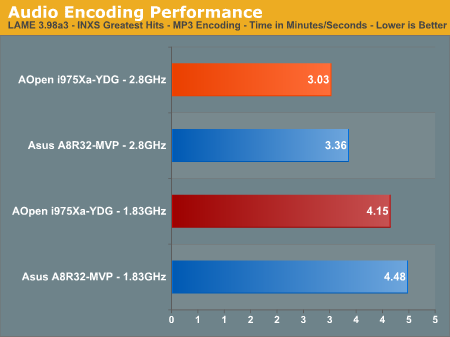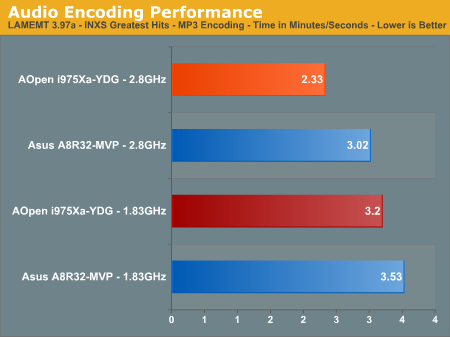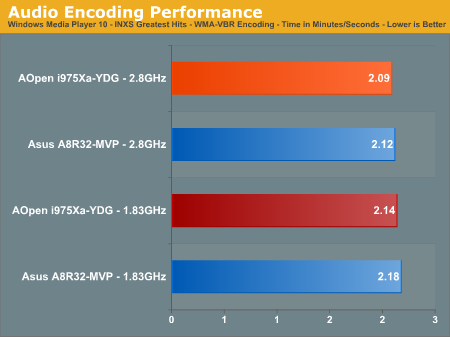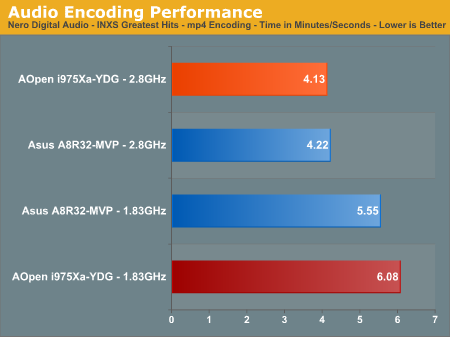Intel Core Duo: AOpen i975Xa-YDG to the Rescue
by Gary Key on May 4, 2006 8:00 AM EST- Posted in
- Motherboards
Audio Encoding Performance
While the media encoding prowess of the Intel processors has been lacking at times, they have generally faired a little better on the audio side. Our audio test suite consists of Exact Audio Copy v095.b4, LAME 3.98a3, LAME MT 3.97a-MS Compiler, Windows Media Player 10, and Nero Digital Audio.Our first task was to figure out what test CD to utilize. We needed one that contained a significant number of tracks and had over 600MB of data in order to properly stress our platforms. After rummaging around the lab and discounting the Burl Ives Greatest Christmas Hits album, we happened upon a CD that would work for our purposes as it was not working for anyone else, INXS Greatest Hits. This one time '80s glory masterpiece contains 16 tracks totaling 606MB of songs that was instantly whisked into our anxiously awaiting optical drive.
Our first test consists of utilizing Exact Audio Copy as the front end for our differing versions of LAME. We setup EAC for variable bit rate encoding, burst mode for extraction, use external program for compression, and to start the external compressor upon extraction (EAC will read the next track while LAME is working on the previous track, thus removing a potential bottleneck with the drive).
Our two versions of LAME consist of the recently released 3.98a3 and LAME MT 3.97a, which is a multi-threaded version of the LAME MP3 encoder. LAME MT was originally designed as a demonstration to show the advantages of multi-threading on the Pentium 4 with Hyper-Threading enabled. Instead of running multiple parallel threads, LAME MT generates the encoder's psycho-acoustic analysis function in a separate thread from the rest of the encoder using a simple linear pipeline and then caches it in the second thread for processing. Further details about the program and its creation can be found here. The results are presented in minutes/seconds for the encoding process, with lower numbers being better.


As in the media encoding section, the more CPU intensive operations seem to favor the Intel platform. We ran these tests several times with the results all being within one second of each other. If we shortened the test to 6 tracks then the AMD platform was within a couple of percent of the Intel platform. As we extended the size of our test samples the performance margin between the two platforms lengthened from a 2% advantage for the Intel platform to almost 11%. It concerned us to the point that we changed our drive image and then our board. We were rewarded with the same results. Running this same test on our 945GM based board resulted in a performance difference around 4% in favor of the Intel platform.
When utilizing LAME MT we see upwards of a 29% improvement in encoding times resulting in scores near that of our overclocked results. This once again shows the advantages programs can gain when they're written to take advantage of multiple-core processors or platforms.
Our next test consists of utilizing the INXS Greatest Hits CD and ripping all 16 tracks with Windows Media Player 10. We set WMP10 to rip the tracks in Widows Media Audio variable bit rate format and moved the slider all the way to the right resulting in a Best Quality request.

The results are very close for both platforms and the only comment here is that a fast optical drive is probably more important than your choice of CPU in this benchmark.
Our last audio test - and we are sure our INXS Greatest Hits CD is ecstatic about this - utilizes Nero Digital Audio to extract all 16 tracks and convert them into an mp4 format. We changed the default quality settings to transcoder-ultra, variable bit rate, encoder quality to high, and the AAC profile to LC. We were determined to give our platforms a workout with this test.

These results invoked the burning of the midnight oil along with some late night phone calls to Nero. In the end, after numerous retests and a run to Best Buy to purchase another copy of the INXS Greatest Hits CD - just to make sure CD scratches weren't causing problems - we have a situation where the AMD platform has a clear advantage at the stock settings in a program that heavily stresses the CPU subsystem. However, the Intel platform shines at the overclocked settings resulting in scores that do not follow any previous patterns in our test results.
We ran these tests over a dozen times with the same results. We noticed that on the last four tracks the Intel system would encode these files quicker than the AMD system, even though the track speed of our optical drive did not change. We thought perhaps our Opteron system was encountering some form of thermal throttling, but our temperature readings showed very little change, and adding active cooling to our OCZ memory still generated the same results.










81 Comments
View All Comments
JarredWalton - Thursday, May 4, 2006 - link
Why did someone mod this post down? I'm serious: if you put an H in brackets, the AT comments engine interprets that as "turn on white text". No insult was intended towards HardOCP; I'm merely pointing out that Frumious' post turned the text white, unintentionally. Thanks for the negative mod points.... :|Frumious1 - Thursday, May 4, 2006 - link
Anyone else getting white text? What's up with that?Test:
[/font]
[/link]
Did that help?
goinginstyle - Thursday, May 4, 2006 - link
At least the quote was a bit different this time but still not needed. I thought the article was great and actually one of the best ones I have read lately. It was nice to finally see two like platforms compared against each other with the same cpu speeds and components although AMD2 would have been good to see.You really should do more of these comparisons as the reviewing one motherboard against another in the same product family gets boring. You never see much of a variance in the scores so the only question is if it sucks or not. At least this way you review the board and compare it against something you might be thinking about buying if you are a Intel or AMD user. You honestly get to see what works best for you. It was nice to see additional real application benchmarks instead of the same old winstone that or 3dmark this.
I was disappointed in not seeing any Photoshop benchmarks or something that has to do with graphics, it would round out your audio and video benchmarks nicely. Anyway, keep up the good work and hopefully you can do this same type of article when Conroe gets here against the AMD products.
In the meantime props to Intel for finally showing some performance improvement without needing a nuclear powerplant for the CPU.
goinginstyle - Thursday, May 4, 2006 - link
Any numbers yet?goinginstyle - Thursday, May 4, 2006 - link
....and temperature readings???Gary Key - Thursday, May 4, 2006 - link
We pulled the charts, the AOpen board uses a thermal sensor instead of the on-chip diode so our numbers are off. Once we decide what number to utilize, these numbers will be posted. If you refer to our Yonah Preview article, the power consumption numbers are listed for the 945GM board. I posted a couple of numbers earlier in this thread with the AOpen board. Thanks....goinginstyle - Thursday, May 4, 2006 - link
Thank you for the update and hopefully we can see these numbers soon.BigLan - Thursday, May 4, 2006 - link
"The rear panel contains the standard PS/2 mouse and keyboard ports, parallel port, LAN port, and 4 USB ports."Looking at the picture, I don't see a parallel port there and it's not listed on the specs either. Did you mean a firewire port?
Also, how useful is the external sata connector? Does the board come with a cable to utilise the power connector?
Gary Key - Thursday, May 4, 2006 - link
Sorry about that, yes, it was suppose to be Firewire. I had it corrected on my final draft and missed it twice in the edits.AOpen ships an excellent cable that has the drive and power port plugs together. I found the external connector to be very useful during testing on the JMicron chipset. Since I really enjoy HTPC tinkering, it will be of great usefulness for attaching or swapping large PVR drives out without entering the system. The JMicron chipset performed very well in our testing and had no issues handling Seagate's new 750GB drive.
BigLan - Thursday, May 4, 2006 - link
Thanks for the reply. Any chance you need an independent review doing on that 750GB drive ;)